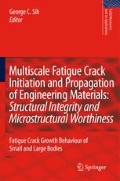The size/time transitory character of fatigue cracking can be hidden in the data or revealed explicitly depending on the manner of presentation. The former can correspond to the crack length while the latter to the crack growth rate variations, both referred to the number of fatigue cycles. Conventionally speaking, the sigmoidal curve for the plot of log da/dN against log ΔK consists of three regions known as I, II and III. They are referred to, respectively, as crack initiation, stable crack growth and fast fracture although the transition from one region to another involving scale shifting is seldom discussed. Even though damage by very small defects are recognized in fatigue but their representation may become dubious when the parameter “a” in the crack growth rate expression da/dN may have to adopt a different physical interpretation. Using the line crack configuration for describing crack growth in metals, reference will be made to three approximate crack size range of a ≈10–80 mm (macromechanical) for regions II and III, a ≈10−3to 10−1mm (micro- structural) for region I and presumably a ≈10−4 mm or smaller (nano-chemical) for the lower scale regions.
The objective of developing a multiscale fatigue crack growth model is to determine the increment of a stress intensity or energy density parameter such that the data in regions I, II and III can be related. One way is to have the crack growth rate da/dN to lie on a straight line such that linear interpolation can be applied to relate the nano, micro and macro fatigue data. This behavior is referred to as form-invariant. The proposed scheme accounts for two succeeding scales such as micro/macro and nano/micro. In this way. the scaling shifting capability can be extended, say from nano to macro. The dual scale micro/macro line crack model will be presented. It consists of three physical parameters d* (micro/macro length), μ* (micro/macro material constants) and σ* (external/internal stresses). The model can also delve into the details of the material microstructure when needed. For structural applications many of the incidental material parameters can be absorbed by the macro empirical parameters which will be limited to two such that the present findings can be incorporated into the current fracture control methodology.
Using the available fatigue crack growth data for the 7075-T6 and 2024-T3 aluminum panels, the sigmoidally-curved regions I, II and III will be shown to become a straight line whose slope and y-intercept in a log-log plot will depend on the mean stress σm and stress amplitude σa that are accounted for simultaneously by the dual scale energy density expression. The slopes of lines line referred to the energy density plots ranged from 2.890 to 3.019 when σm varied from 9 to 12 kg/mm2 and σa from 2.5 to 6.5 kg/mm2. The slopes obtained a wider scatter of 3.532 to 4.224 when the energy density range was replaced by the stress intensity range. This was expected because the stress intensity approach leaves out the mean stress effect. The present work is offered as the first step to include scaling effects so that micro material behavior can enter into the macro fatigue crack growth process.
Access this chapter
Tax calculation will be finalised at checkout
Purchases are for personal use only
Preview
Unable to display preview. Download preview PDF.
Author information
Authors and Affiliations
Editor information
Editors and Affiliations
Rights and permissions
Copyright information
© 2008 Springer Science+Business Media B.V
About this paper
Cite this paper
Sih, G.C. (2008). Invariant Form of Micro-/Macro-Cracking in Fatigue. In: Sih, G.C. (eds) Multiscale Fatigue Crack Initiation and Propagation of Engineering Materials: Structural Integrity and Microstructural Worthiness. Solid Mechanics and its Applications, vol 152. Springer, Dordrecht. https://doi.org/10.1007/978-1-4020-8520-8_8
Download citation
DOI: https://doi.org/10.1007/978-1-4020-8520-8_8
Publisher Name: Springer, Dordrecht
Print ISBN: 978-1-4020-8519-2
Online ISBN: 978-1-4020-8520-8
eBook Packages: EngineeringEngineering (R0)

